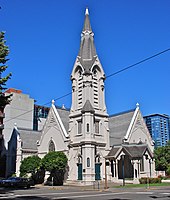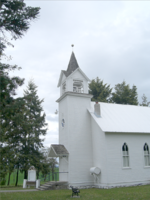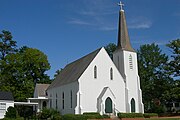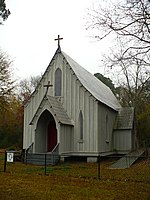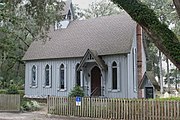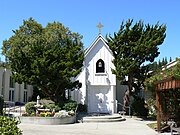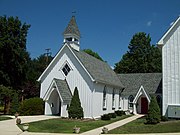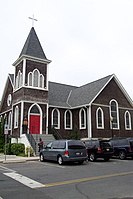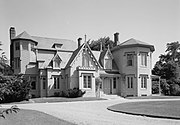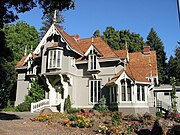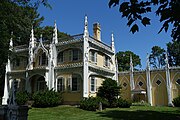Carpenter Gothic




Carpenter Gothic, also sometimes called Carpenter's Gothic or Rural Gothic, is a North American architectural style-designation for an application of Gothic Revival architectural detailing and picturesque massing applied to wooden structures built by house-carpenters. The abundance of North American timber and the carpenter-built vernacular architectures based upon it made a picturesque improvisation upon Gothic a natural evolution. Carpenter Gothic improvises upon features that were carved in stone in authentic Gothic architecture, whether original or in more scholarly revival styles; however, in the absence of the restraining influence of genuine Gothic structures,[1] the style was freed to improvise and emphasize charm and quaintness rather than fidelity to received models. The genre received its impetus from the publication by Alexander Jackson Davis of Rural Residences and from detailed plans and elevations in publications by Andrew Jackson Downing.
History
Carpenter Gothic houses and small churches became common in North America in the late nineteenth century.
Characteristics
Carpenter Gothic is largely confined to small domestic buildings and outbuildings and small churches. It is characterized by its profusion of jig-sawn details, whose craftsmen-designers were freed to experiment with elaborate forms by the invention of the steam-powered
Ornamental use
Being a part of the Gothic Revival, the ornamentation in Carpenter Gothic is much more eclectic, it uses more superficial and obvious motifs.
Geographic extent
Carpenter Gothic structures are typically found in most states of the United States, except
Endangered Carpenter Gothic buildings
Many American Carpenter Gothic structures are listed on the National Register of Historic Places, which may help to ensure their preservation. Many, though, are not listed and those in urban areas are endangered by the increased value of the land they occupy.
A current example of this is St. Saviour's Episcopal Church,
After a number of postponements, in March 2008, just hours before the final deadline to demolish the church, a deal was struck with a local community group, whereby they were allowed time to raise money to move the structure. At a cost of some $2 million, the building was reduced to its original appearance and dismantled into pieces, so it could be transported through the narrow, winding streets of the neighborhood. It was reconstructed on the grounds of a cemetery in the nearby neighborhood of
"American Gothic"
"American Gothic" is a painting by Grant Wood from 1930. It depicts American rural life with its subject being a “stern” looking father and his daughter in front of a small Carpenter Gothic style house.[3] Wood's inspiration came from a cottage designed in the Carpenter Gothic style with a distinctive upper window[12] and a decision by the artist to paint the house along with "the kind of people I fancied should live in that house."[13]
Steamboat Gothic

Steamboat Gothic architecture, a term popularized by Frances Parkinson Keyes's novel of that name,[14] is sometimes confused with Carpenter Gothic architecture,[15][16] but Steamboat Gothic usually refers to large houses in the Mississippi and Ohio river valleys that were designed to resemble the steamboats on those rivers.[17]
Recent examples
Outside North America
-
Local Catholic church of Konga, Larantuka, Indonesia. (circa 1915)
-
St Mary's Cathedral of Auckland, completed in 1898.
-
St. Mary's Catholic Church of Stanley, Falkland Islands, constructed in 1899.
Many nineteenth-century timber
Gallery
Churches, synagogues, etc.
-
Emmanuel Episcopal Church, Eastsound, Orcas Island Washington
-
St Mary's Episcopal Church and Rectory,Milton, Florida
-
Pioneer Gothic Church, Dwight, Illinois, originally a Presbyterian church
-
Unitarian Universalists of San Mateo, California, California, originally a Methodist church
-
The Old Church (Portland, Oregon), originally Calvary Presbyterian Church
-
St. Andrew's Episcopal Church, Prairieville, Alabama Note the buttresses.
-
La Grange Church, Titusville, Florida, originally non-denominational Protestant
-
St. Mark's Episcopal Church (Palatka, Florida). Note the buttresses at the base of the belfry.
-
Andrews Memorial Chapel (Dunedin, Florida), originally a Presbyterian church
-
Bethany Memorial Chapel (Kendrick, Idaho), originally a Norwegian Lutheran church
-
Tualatin Plains Presbyterian Church, Hillsboro, Oregon
-
St. Paul's Episcopal Church, Lowndesboro, Alabama
-
St. John's-In-The-Prairie Episcopal Church, Forkland, Alabama
-
St. Luke's Episcopal Church, Cahaba, Alabama
-
St. Margaret's Episcopal Church (Hibernia, Florida).
-
Gethsemane Evangelical Lutheran Church, Detroit, Michigan
-
St. Agatha's Episcopal Church, DeFuniak Springs, Florida. Note the unusual tower.
-
St. Paul's by-the-sea Protestant Episcopal Church, Ocean City, Maryland
-
Temple Israel, Leadville, Colorado, 1884 Reform synagogue.
-
St. Mary's Church (Green Cove Springs, Florida)
Houses
Plain
-
Cottages in a former Methodist camp town in Oak Bluffs, Massachusetts on Martha's Vineyard.
-
Peters-Liston-Wintermeier House in Eugene, Oregon
-
Wilson-Durbin House in Salem, Oregon
-
Blydenburgh Farmhouse Cottage, built 1860 in Smithtown, New York
-
James S. and Jennie M. Cooper House, Independence, Oregon
Ornate
-
Kingscote in Newport, Rhode Island, built in 1839.
-
Afton Villa, a former plantation house in West Feliciana Parish, Louisiana. Built from 1848 to 1856, the masonry structure burned in 1963.
-
J. M. Bonney House in Buena Vista, Colorado, built in 1883
-
Eugene Saint Julien Cox House in St. Peter, Minnesota, built in 1871
-
Indian Range, in Davidsonville, Maryland, built in 1852
-
Roseland Cottage, Woodstock, Connecticut
-
Ashe Cottage, Demopolis, Alabama
-
Justin Smith Morrill Homestead Strafford, Vermont
-
Athenwood, Montpelier, Vermont, built 1850
-
Waldwic, Gallion, Alabama
-
J. Mora Moss House in Mosswood Park, Oakland, California
Ornamental use
-
Warren House, Gothic Revival brick house with Carpenter Gothic trim and features, Newburgh, New York,Historic District
-
"Wedding Cake House" in Kennebunk, Maine, United States. Example of a house built in an older style modified in the Carpenter Gothic style in the mid-1800s.
See also
- Andrew Jackson Downing
- American Gothic
- Gothic Revival
- Gingerbread (architecture)
- Richard Upjohn
- Springside
- Stick style
- Structure relocation
- United Hebrews of Ocala, a Carpenter Gothic synagogue
- Wedding Cake House (Kennebunkport, Maine). Called the "most photographed building in Maine," it is an example of Carpenter Gothic remodeling of a frame building originally built in another style of architecture.
- Harmony School, School District No. 53 in rural Otoe County, Nebraska is an example of a Carpenter Gothic one-room schoolhouse.
References
- ^ The British denigration of Sir George Gilbert Scott's restorations at Ely Cathedral as "Carpenter's Gothic" are discussed in Phillip Lindley, "'Carpenter's Gothic' and Gothic Carpentry: Contrasting Attitudes to the Restoration of the Octagon and Removals of the Choir at Ely Cathedral". Architectural History 30 (1987:83–112).
- ^ What Style Is It?, Poppeliers, et al., National Trust for Historic Preservation
- ^ JSTOR 43487497– via JSTOR.
- ^ a b Encyclopædia Britannica. "Carpenter Gothic". Britannica Academic.
- ^ "Departments and Officials of Wapello County, Iowa". www.wapellocounty.org. Retrieved 2023-04-30.
- ^ "Carpenter Gothic". History Colorado. Retrieved 1 March 2021.
- ^ ISBN 9780847836192.
- ^ Kyles, Shannon. "carpenter". www.ontarioarchitecture.com. Archived from the original on 21 August 2016. Retrieved 9 May 2018.
- ^ "The Serious Side of Carpenter Gothic: Why Richard Upjohn Wanted to Build a Country Church in Maspeth - JuniperCivic.com". www.junipercivic.com. Archived from the original on 8 March 2017. Retrieved 9 May 2018.
- ^ Lauinger, John (12 December 2007). "St. Saviour Church for sale at $10M - NY Daily News". New York Daily News. Archived from the original on 29 June 2011. Retrieved 9 May 2018.
- ^ Angelos, James (April 6, 2008). "For a Church Bathed in History, a Last-Minute Miracle". The New York Times. Archived from the original on 26 September 2015. Retrieved 12 March 2013.
- ^ "Grant Wood" Archived 2011-10-31 at the Wayback Machine, Art Institute of Chicago. Retrieved December 14, 2008.
- ISSN 1091-2339. Retrieved 2023-04-30.
- ^ "Steamboat Gothic by Frances Parkinson Keyes". www.fantasticfiction.com. Retrieved 2023-04-30.
- ^ "Steamboat Gothic". pplans.com. Archived from the original on 2 October 2011. Retrieved 9 May 2018.
- ^ "Mississippi River, acreage, homes, farms, fishing, hunting, cabins, woods". Archived from the original on 2008-04-08. Retrieved 2007-11-06. See listing number 235, accessed 11-5-2007
- ^ "Definition of STEAMBOAT GOTHIC". www.m-w.com. Retrieved 9 May 2018.
- ^ "St. Luke's Episcopal Church of Blue Ridge, Georgia - Episcopal Missionary Church". www.stlukesblueridge.org. Archived from the original on 14 March 2018. Retrieved 9 May 2018.
- ^ "Category:Carpenter Gothic churches in Australia - Wikimedia Commons". commons.wikimedia.org. Archived from the original on 20 May 2015. Retrieved 9 May 2018.
External links
- Carpenter Gothic houses Archived 2007-11-14 at the Wayback Machine
- Bargeboards or vergeboards Archived 2008-01-16 at the Wayback Machine
- Gothic Revival and Carpenter Gothic in Buffalo
- The serious side of Carpenter Gothic: Richard Upjohn and St. Saviour's Church, Maspeth, Queens, New York Archived 2017-03-08 at the Wayback Machine
- Website of the C.G. House used by Grant Wood
- Village of Round Lake, New York
- Essential Architecture: Carpenter Gothic










